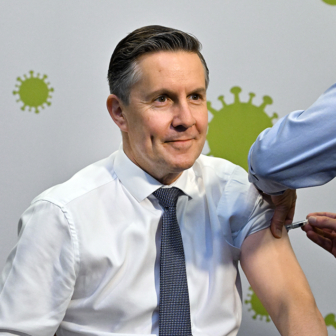The UN General Assembly spent a day last week discussing strategies for ridding the world of tuberculosis by 2030. It was the first ever “high-level meeting” on the subject at the UN, designed to attract not just diplomats and foreign ministers but also heads of government, about twenty-five of whom attended. In other words, the UN deemed it a high priority.
What does this have to do with Australia, a country that largely eradicated the disease several generations ago? Judging by our attendance, not too much. Foreign minister Marise Payne was there, and issued a statement reaffirming Australia’s “commitment to end the tuberculosis epidemic,” but she said nothing about the 2030 deadline or the specific measures in the meeting’s declaration.
You can argue that a sense of altruism would be one reason for one of the wealthiest nations on earth to get involved — but only if you ignored our shameful slashing of the foreign aid budget to one of the lowest levels among developed nations. But there is another reason with potentially greater appeal to a hard-hearted government: self-interest.
A few kilometres across the Torres Strait, TB is rife. While Australia has seven new cases each year per 100,000 people, Papua New Guinea reports 432 per 100,000, and that is certain to be an underestimate given that the disease often goes undiagnosed and untreated. The official figure ranks PNG as having the tenth-highest rate of the disease in the world, with 31,000 new cases reported each year and more than 3000 deaths.
Once diagnosed, TB can readily be treated, which is why it has largely been eliminated in developed countries. Tackling it is mainly a matter of resources: conducting diagnoses and providing medicines and the staff to administer them. The current lack of commitment and resources makes it the leading cause of death by infectious disease in the world, killing 1.6 million last year in Africa, parts of Asia and the western Pacific. It is a disease of poverty, transmitted through coughs and sneezes and exacerbated by poor health and overcrowded housing.
It also is a matter of priorities. Malaria and HIV are also relatively easy to detect and treat, and huge inroads have been made into tackling them thanks to major funding provided by bodies such as the Global Fund to Fight AIDS, Tuberculosis and Malaria. Yet TB receives less than 20 per cent of the total funding for these three diseases, says Suman Majumdar of Australia’s Burnet Institute. One consequence is the emergence of drug-resistant strains of TB that are less susceptible to easy treatment. The cost of treating standard TB in PNG is $62; for the drug-resistant strains, with a success rate of 54 per cent, it is above $12,000.
Nevertheless, Australia has shown a willingness to help on occasions, the outstanding example being in PNG’s western province, that part of the country closest to Australia. Which takes us back to self-interest.
In 2012, Anna Bligh’s Labor government in Queensland stopped funding clinics on Torres Strait islands that were part of Australia and were easily accessible to people from PNG under the Torres Strait treaty that allows free movement of people on either side of the border. Although jointly funded, the Gillard government refused to fill the funding gap and the clinics closed down.
The argument for this version of stopping the boats was to avoid the risk of the disease spreading to Australia, with many patients making it to Cairns hospital. And the supposed justification was that they were the responsibility of PNG. With the most basic services in PNG provided sporadically at best, many patients were left untreated.
But then it was revealed that Daru, a small Torres Strait island in PNG’s western province, had the dubious distinction of the highest infection rate in the world for drug-resistant strains of TB. The risks of its rapid spread in PNG and to Australia were high.
Spurred by this emergency, the Australian government spent almost $50 million in foreign aid money on treating and preventing TB in Daru and nearby areas during the six years to 2017. According to the Burnet Institute’s director, Brendan Crabb, “aid programs are often criticised for being ineffective but this is a good example of success.” Marise Payne’s predecessor, Julie Bishop, claimed in 2015 that deaths from drug resistant TB in western province had fallen from about 25 per cent of cases to fewer than 1 per cent.
Burnet, in partnership with the PNG government and World Vision, implemented a comprehensive and innovative program. New and more effective diagnosis and treatments were introduced. Members of the local community who had survived TB were trained to help patients complete their treatment by ensuring they took their medication daily, with counselling, education and even hot meals. One of the biggest challenges in tackling TB is that curing the disease requires six months of daily treatment; for the drug-resistant strains, this can stretch to two years.
Despite Crabb’s enthusiasm for the program, he says the job is only half done. Really bringing the rates down will require large-scale detection, treatment and, importantly, prevention of latent TB, including its drug-resistant forms, he says. One step is the systematic screening program that has been introduced on Daru, with everyone ten years and older being checked for signs of the disease.
Heartening as the progress on Daru is, it was an emergency response. Along with the Australian government and the partnership between Burnet, World Vision and the PNG government, the World Bank and the World Health Organisation also became involved — a scale of operation unlikely to be replicated in many places. Without continuing commitment, the risk is that the rates will go back up again.
Resources and commitment are always a challenge in PNG, with hospitals regularly running short of medicines and other supplies. In July, local MP Sekie Agisa said two nursing staff at Daru hospital had caught TB because of a lack of the most basic supplies, including face masks, drugs and repairs to an X-ray machine that had stopped working.
Daru has a population of just 16,000 in a nation of more than eight million. An estimated 90 per cent of people in the developing world have a latent form of TB. In most cases it will remain dormant but it is triggered by a weak immune system in people who are ill or malnourished. If active and left untreated, each person will infect another ten to fifteen people a year. Combined with chronic communication and transport problems, this brings home the scale of the challenge.
Harvard Medical School’s Jennifer Furin and Cape Town University’s Helen Cox, both experts on TB, have described the efforts to tackle drug resistant TB in PNG as “woefully inadequate.” Writing in 2016, they asked: “Why does there seem to be a double standard in implementation of action on outbreaks of deadly infectious diseases? Evidence shows that [multi-drug resistant TB], which is spread through the air, is just as deadly as Ebola and has health, population and economic consequences that will almost certainly eclipse those of both the Ebola and recent Zika virus outbreaks — deemed a global public health emergency — combined.”
The fact that tuberculosis is a disease of poverty poses another problem. Compared to the research funds poured into new drugs and technologies in areas such as cardiovascular disease and cancer, where there are potentially large returns on investment, TB barely rates.
As a result, many diagnoses of TB in low- and middle-income countries are still conducted in the same way as they were a century ago — by a doctor’s clinical judgement and by examining sputum samples under a microscope, with samples sometimes sent away for further analysis in a process that can take weeks or months.
Promising developments in recent years include a new drug and the new GeneXpert diagnostic test that can provide results in two hours and with much greater accuracy. But higher costs, the need for a power supply and for maintenance are major barriers to widespread adoption of this new test in PNG and other countries.
The UN meeting commits governments to treat forty million people with TB in the next four years and provide preventive treatment for another thirty million vulnerable to the disease. A total of $US13 billion a year would be spent by 2022 to provide universal access to prevention, diagnosis, treatment and care of TB and spending on research into TB would increase from $US700 million a year to $US2 billion.
How Australia and other countries will translate these noble sentiments and aspirations into action remains to be seen. •




